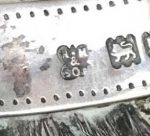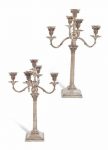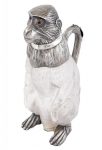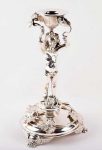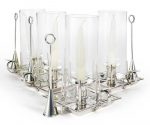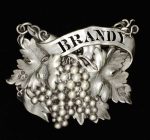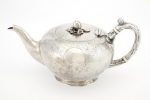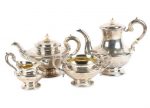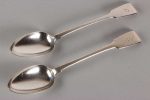Richard Hodd & Son made some exquisite silverware and silver plate, including some rare novelty silver mounted claret jugs, such as the monkey claret jug below. Their mark has been found on other items such as candlesticks and bottle lables.
Richard Hodd and Sons Silver Makers Mark
A PAIR OF VICTORIAN SILVER FIVE-LIGHT CANDELABRA MARK OF RICHARD AND RICHARD HODD, LONDON, 1880 Each on stepped base with cast Corinthian column stem, with four foliage-cast branches, two detachable for an alternate fitting for three-lights, with cast Corinthian capital sockets and detachable nozzles, with further central branch, marked on base, branches, central branch and nozzles, the bases filled 24 ¼ in. (61.5 cm.) high
Sold for GBP 5,625 at Christies in 2017
Rare Edwardian Sterling Silver Mounted Glass Novelty Monkey-Form Claret Jug Richard Hodd & Son, London, 1906 Realistically modelled seated on his hind legs with textured glass body, the hinged head with glass eyes. Height 11 1/4 inches (28.5 cm). The Victorian taste of the unusual is at its most striking in the animals used in claret jugs. A whole menagerie was available from cockatoos, ducks and owls to much rarer monkeys, walruses and even kangaroos. Perhaps because they were intended to be used for after dinner drinks few appear on the market today.
Sold for $11,875 (includes buyer’s premium) at Doyle New York in 2019
A single Victorian cast silver candlestick London 1880, the mark of Richard Hodd and Son, in the form of Bacchus with twined grape vine decoration to the base, raised on three clawed feet.13 ozt. 21cm high.
Sold for £250 at Dawson’s Auctioneers in 2019
A set of four Victorian silver chamber candlesticks, Richard Hodd & Son, London, 1880-1 square bases, crested thumbpieces, snuffers with ring handles, with hurricane glass shades fully marked, base with retailer stamp Dobson Piccadilly and design registry marks length of base 5 in., height with shade 7 7/8 in. 12.7 cm, 20 cm 48 oz 15 dwt 1518 g
Sold for 9,375 USD at Sothebys in 2015
Bottle ticket with the word BRANDY (pierced lettering). Silver, ribbon above a vine leaf and grapes with chain attached.
This bottle ticket would have hung round the neck of a bottle of brandy. Bottle tickets identified the contents of a bottle or decanter, which might alternatively contain spirits, sauces, toilet waters or cordials. Contemporary gazettes begin to refer to ‘labels for bottles’ in the 1770s but it was not until the 1790s that they were established as wine or decanter labels. The history of bottle tickets provides a fascinating insight into English eating, drinking and personal habits. These tickets also illustrate, in miniature, the skills of the silversmith over the last two hundred years. While the variety of styles and materials was enormous, silver bottle tickets tended to reflect fashionable designs and technical advances in metalware generally.
Reference: © Victoria and Albert Museum
Victorian Sterling Silver Teapot William Smily for A B Savory & Sons, London, 1856 Length 10 1/4 inches, approximately 22 ounces, all in.
Sold for $406 (includes buyer’s premium) at Doyle New York in 2016
A.B. Savory Sterling Silver Tea Set London, England. Four (4) pieces. Circa 1834. Made by A.B. Savory & Sons. Includes teapot, coffee pot, creamer, open sugar. Finials bone, plain body with scroll handles. Gross weight, 2172g. Tallest piece 8.5″
Sold for CA$1,100 at Miller & Miller Auctions Ltd. in 2018
Pair of George III Sterling Silver Basting Spoons hallmarked, London, 1813, A.B.S (Adey Bellamy Savory), in fiddle pattern with monogram, total weight 313gm, l 31cm, (2)
Sold for A$400 at Aalders Auctions in 2018
